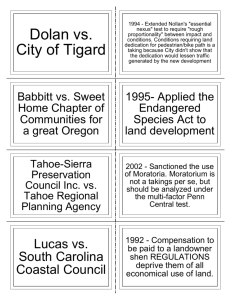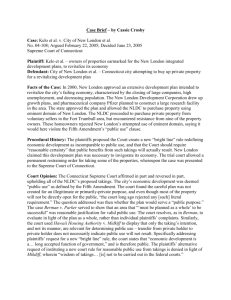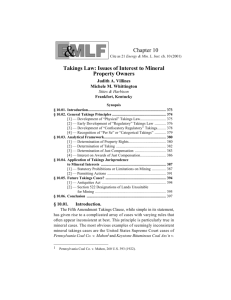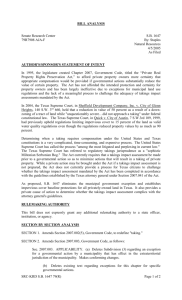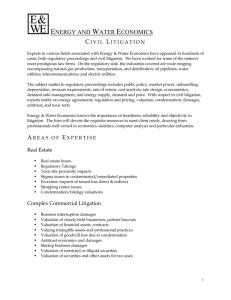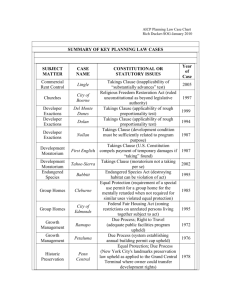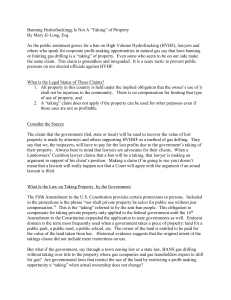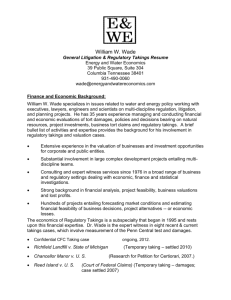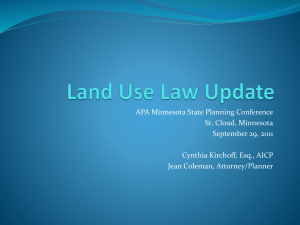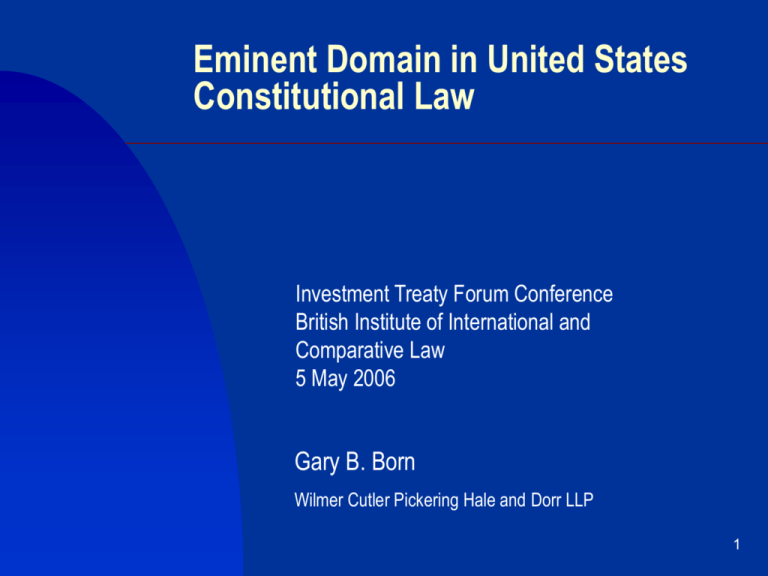
Eminent Domain in United States
Constitutional Law
Investment Treaty Forum Conference
British Institute of International and
Comparative Law
5 May 2006
Gary B. Born
Wilmer Cutler Pickering Hale and Dorr LLP
1
Fifth Amendment Takings Clause
Takings Clause: “. . . nor shall private property be taken
for public use, without just compensation.”
Due Process Clause – Fifth Amendment: “No person shall
. . . be deprived of life, liberty, or property, without due
process of law. . .”
Due Process and Equal Protection Clauses – Fourteenth
Amendment:
“. . . nor shall any State … deny to any person within its
jurisdiction the equal protection of the laws.”
2
Historical Origins of Takings
Clause
“Fifth Amendment . . . [is] designed to bar
Government from forcing some people alone to
bear public burdens which, in all fairness and
justice, should be borne by the public . . .” Penn
Central Transp. Co. v. City of New York, 438 U.S.
104, 123 (1978) (quoting Armstrong v. United
States, 364 U.S. 40, 49 (1960)).
Relatively limited use of Takings Clause for more than
100 years after adoption
3
Origin of “Regulatory Takings”
Doctrine
Takings historically limited to direct expropriation /
eminent domain
Pennsylvania Coal Co. v. Mahon: Takings Clause
requires just compensation for so-called regulatory
takings
4
Origin of “Regulatory Takings”
Doctrine
Justice Brandeis’ dissent:
“[R]estriction imposed to protect the public health,
safety or morals from dangers threatened is not a
taking. The restriction here in question is merely the
prohibition of a noxious use. The property so restricted
remains in the possession of its owner. . . . [W]here the
police power is exercised, not to confer benefits upon
property owners but to protect the public from detriment
and danger, there is in my opinion, no room for
considering reciprocity of advantage.” Mahon, 260 U.S.
at 422.
5
Origin of “Regulatory Takings”
Doctrine
Justice Holmes’ majority:
“As applied in this case, the statute is admitted to destroy
preexisting rights of property and contract. The question is
whether the police power can be stretched so far. Government
hardly could go on if to some extent values incident to
property could not be diminished without paying for every
such change in the general law. . . . The general rule at least
is that while property may be regulated to a certain extent, if
regulation goes too far it will be recognised as a taking.” 260
U.S. at 413.
Court holds that statute’s essentially complete destruction of the
mineral rights reserved by the coal company constituted a taking
6
Overview of Contemporary Takings
Law
Lack of clear rules under Takings Clause, particularly in
regulatory takings analysis
U.S. Supreme Court has repeatedly said that there is no
“set formula,” Goldblatt v. Town of Hempstead, 369 U.S.
590, 594 (1962);
Takings analysis depends largely on “essentially ad hoc,
factual inquiries.” Penn Central, 438 U.S. at 124.
7
Overview of Contemporary Takings
Law
Doremus, Takings and Transitions, 19 J. Land Use & Envtl. L. 1, 1-2 (2003)
(regulatory takings law “famously incoherent”)
Bell & Parchomovsky, Takings Reassessed, 87 Va. L. Rev. 277, 278 (2001)
(“Takings jurisprudence is replete with inconsistent distinctions that provide
scant guidance for courts and policymakers.”)
Schroeder, Never Jam To-day: On the Impossibility of Takings
Jurisprudence, 84 Geo. L.J. 1531, 1531 (1996) (Takings jurisprudence is a
“top contender for the dubious title of ‘most incoherent area of American
law.’”)
Farber, Public Choice and Just Compensation, 9 Const. Comment. 279, 279
(1992) (“[T]akings doctrine is a mess.”)
8
Overview of Contemporary Takings
Law
Peterson, The Takings Clause: In Search of Underlying Principles,
77 Cal. L. Rev. 1301, 1304 (1989) (“[I]t is difficult to imagine a body
of case law in greater doctrinal and conceptual disarray.”)
Rose, Mahon Reconstructed: Why the Takings Issue is Still a
Muddle, 57 S. Cal. L. Rev. 561, 561-62 (1984) (Takings
jurisprudence is “[b]y far the most intractable constitutional property
issue.”)
Epstein, The Seven Deadly Sins of Takings Law, 26 Loy. L.A. L. Rev.
955, 956 (1993) (“[M]ak[ing] sense of the Takings Clause . . . is
complicated enough when the constitutional text stands alone, but it
has been made more formidable still by the grotesque judicial gloss
on the clause that now passes for constitutional interpretation.”)
9
Overview of Contemporary Takings
Law
Despite a general absence of clear rules, it is possible to derive a few principles,
even in the field of regulatory takings:
Eminent Domain - acquisition of title or formal expropriation virtually always
requires just compensation – United States v. Gen. Motors Corp. (1945);
Permanent physical occupation of property virtually always requires just
compensation - Loretto v. Teleprompter Manhattan CATV Corp. (1982);
Total (100%) destruction of property value generally requires just
compensation, subject to general nuisance doctrine - Lucas v. South
Carolina Coastal Council (1992);
Ordinary Regulatory Takings Claims Generally Subject to Multi-Factor
Analysis - Penn Central Transp. Co. v. City of New York (1978); Tahoe-Sierra
Preservation Council, Inc. v. Tahoe Regional Planning Agency (2002).
10
Permanent Physical Occupation:
Loretto
New York statute requiring land owner to permit installation
of cable television cable and directional taps on private
rental property
U.S. Supreme Court held that statute effected a regulatory
taking:
“[A] permanent physical occupation authorized by government
is a taking without regard to the public interests it may serve”;
“a physical intrusion [is] a property restriction of an unusually
serious character for purposes of the Takings Clause … when
the physical intrusion reaches the extreme form of a
permanent physical occupation, a taking has occurred.”
Loretto, 458 U.S. at 426.
11
Total Destruction of Economic
Value: Lucas
South Carolina Beachfront Management Act - no
construction within specified distance from beachfront
“[W]e have found categorical treatment appropriate . . .
where regulation denies all economically beneficial or
productive use of land.” Lucas v. South Carolina
Coastal Council, 505 U.S. 1003, 1015 (1992).
100% loss of value required for categorical treatment;
NOT 90%
12
Lucas Exception: Nuisance Law
Lucas exception: Background principles of nuisance law
“where the State seeks to sustain regulation that deprives
land of all economically beneficial use, we think it may resist
compensation only if the logically antecedent inquiry into the
nature of the owner's estate shows that the prescribed use
interests were not part of his title to begin with”; “must
inhere in the title itself, in the restrictions that background
principles of the State's law of property and nuisance
already place upon land ownership” Lucas, 505 U.S. at
1027.
13
Lucas Exception: Nuisance Law
Examples:
zoning restrictions - Village of Euclid v. Ambler Realty (1926)
industrial uses prohibited - Hadacheck v. Sebastian (1915)
(brickyard plant operations in urban areas); United States v.
Central Eureka Mining Co. (1958) (non-essential gold mine);
Mugler v. Kansas (1887) (brewery)
height restrictions - Welch v. Swasey (1909)
health/crop restrictions - Miller v. Schoene (1928) (destruction
of ornamental cedars)
14
“Ordinary” Regulatory Takings
Claims: Penn Central Factors
In contrast to the categorical per se rules under Loretto and Lucas, most
regulatory takings claims are subject to ad hoc, case-by-case analysis.
Penn Central Transp. Co. v. City of New York, 438 U.S. 104 (1978): NY
Court of Appeals held that there could be no taking “since the
[Landmarks Preservation Law] had not transferred control of the
property to the city, but only restricted appellants’ exploitation of it.”
US Supreme Court held that, for alleged regulatory taking, the Fifth
Amendment required “essentially ad hoc, factual inquiries,” with
“several factors that have particular significance.”
15
“Ordinary” Regulatory Takings
Claims: Penn Central Factors
Three Penn Central factors:
“economic impact of the regulation on the claimant”
“the extent to which the regulation has interfered with
distinct investment-backed expectations”
“the character of the governmental action” – “A ‘taking’
may more readily be found when the interference can
be characterised as a physical invasion by
government, than when interference arises from some
public program adjusting the benefits and burdens of
economic life to promote the common good”
16
“Ordinary” Regulatory Takings
Claims: Penn Central Factors
Penn Central held that permit denial was NOT a taking:
other uses of property, including profitable use, are permitted by
statute;
no interference with present uses of property by statute, including
historic use as a terminal (not office building);
development rights available for claimants with regard to their other
properties;
possibility for application for different office tower, which might be
approved;
comprehensive, city-wide scheme, which did not single out claimants
or Grand Central Terminal;
positive impact of legislation on property values;
17
“Ordinary” Regulatory Takings
Claims After Penn Central
Supreme Court has not clarified the Takings Clause
materially since Penn Central
Numerous, sharply-divided opinions; ideological divide
A few generalizations may be made:
Magnitude of Economic Harm (Lucas)
Interference with "Distinct Investment Backed
Expectations" Correlates with Greater Likelihood of
Taking (Lingle v. Chevron, U.S.A., Inc.)
Departure from Settled Custom (Eastern Enterprises
v. Apfel)
18
“Ordinary” Regulatory Takings
Claims After Penn Central
Magnitude of Interference with Private Rights/Control
(Eureka and Pewee)
Magnitude of Temporal and Spatial Intrusion (Tahoe)
Magnitude of Physical Invasion (United States v.
Causby)
“Singling Out,” Particularly of Disfavoured Parties
(Lucas)
19
“Ordinary” Regulatory Takings
Claims After Penn Central
Violation of Government Assurances / Promises
(United States v. Winstar Corp.)
Government Actions Must Be Logically Related and
Proportional to the Stated Government Objectives
(Nollan v. Calif. Coastal Comm'n; Dolan v. City of
Tigard)
No Reciprocity of Advantages (Village of Euclid)
20
Conclusion
CAFTA Chapter 10 (Investments) Annex 10-C, para. 4:
“4.
The second situation addressed by Article 10.7.1 is indirect expropriation,
where an action or series of actions by a Party has an effect equivalent to
direct expropriation without formal transfer of title or outright seizure.
(a)
The determination of whether an action or series of actions by a
Party, in a specific fact situation, constitutes an indirect expropriation,
requires a case-by-case, fact-based inquiry that considers, among
other factors:
(i) the economic impact of the government action, although the fact that
an action or series of actions by a Party has an adverse effect on the
economic value of an investment, standing alone, does not establish
that an indirect expropriation has occurred;
(ii) the extent to which the government action interferes with distinct,
reasonable investment backed expectations; and
(iii) the character of the government action.
(b)
Except in rare circumstances, nondiscriminatory regulatory actions by
a Party that are designed and applied to protect legitimate public
welfare objectives, such as public health, safety, and the
21
environment, do not constitute indirect expropriations.”

